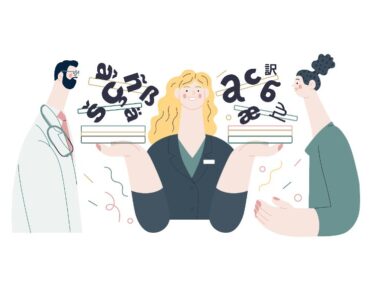by Luke Smith
In today’s increasingly diverse society, the rich tapestry of languages is undeniably a valuable part of a thriving culture. Nevertheless, this linguistic diversity can also present challenges, particularly in the realm of healthcare. When individuals face language barriers while seeking medical assistance and advice, communication breakdowns can occur, impeding the delivery of quality healthcare.
As a result, medical translation services have emerged as an essential tool in the healthcare industry. It plays a vital role in breaking down language barriers and ensuring effective communication between providers and patients. By bridging the linguistic gaps in healthcare, medical translation enhances patient safety and satisfaction but also contributes to the overall improvement of healthcare outcomes for a multicultural community.
Addressing Healthcare Challenges
The healthcare industry faces a range of challenges. Medical translation, while considered one of the more difficult subject areas to translate, is among the tools that can help address some of the significant difficulties. Perhaps paramount among these is the need for effective and efficient communication. Often, a medical provider’s ability to explain the details of a condition and care in a clear and empathetic way can impact outcomes. This is difficult enough when both patient and doctor speak the same language.
Medical translation plays a key role in helping patients and doctors have meaningful interactions about care. Professionals with these skills provide accurate translations for both parties, ensuring doctors receive the nuances of a patient’s symptoms and that patients fully grasp the technical information conveyed in ways that enable them to make informed decisions about their healthcare.
Another significant challenge the industry faces at the moment is the shortage of skilled healthcare workers. An aging workforce, a population that is living longer, and staff burnout have resulted in a lack of doctors, nurses, and healthcare educators in particular. This can mean that there are not enough medical staff to effectively interact with an increasingly diverse population in appropriate languages. As a result, professional translators can be a vital tool in bridging the care gaps caused by labor issues.
The Difference Diversity Makes
Diversity in healthcare is increasingly recognized as a vital consideration when striving to meet the needs of an increasingly multicultural public. After all, patients deserve to have access to inclusive environments in which they feel respected and receive equal quality treatment regardless of their backgrounds. As a result, prioritizing medical translation as part of facilities’ diversity programs can have a positive impact.
Certainly, an important step here is to ensure patients always have access to professional medical translation services. Many larger healthcare facilities are able to overcome language barriers by having translators on staff, though this can make services more expensive for patients. Ideally, administrators should identify solutions to provide translations at no or minimal costs to users.
This has become a legal imperative as of late. Section 1557 of the Affordable Care Act requires all facilities that receive funding from the Federal government to provide medical translation services. Even beyond the legal requirement, facilities have an ethical duty to reduce care access disparities.
Part of the solution to meet the need for medical translation can be for facilities to offer language training to staff members. Preferably, this should be in the form of specialist medical translation certifications, as this ensures industry relevance. Though, even investing in staff’s general multilingual skill sets can be valuable.
Often the most cost-effective, convenient, and culturally forward-thinking approach is to concentrate on diversifying the workforce. Facilities should work with their human resources (HR) teams to hire medical staff from various backgrounds with a native understanding of foreign languages common to the local community. This means that patients not only benefit from access to in-person translation. These professionals should also have a good understanding of the culture of the countries non-English speakers come from, which can result in more meaningful, sensitive, and informed interactions.
The Impact on Community Wellness
Language barriers in healthcare aren’t just an issue when patients head to appointments. They can also result in health disparities in the wider community. Limited English proficiency can hinder knowledge about services available, actions that can boost wellness, and advice about current public health issues. Medical translation helps to address this issue.
Medical translation can be particularly important when designing literature for the wider community. Websites, pamphlets, and social media content are increasingly vital tools for enabling the public to take control of their well-being. Indeed, having a good understanding of preventative health measures improves long-term wellness, minimizes medical debt, and boosts quality of life. This goes beyond general physical health and must include steps to safeguard mental, dental, and eye health. Offering options for multilingual materials help ensure community members of different backgrounds benefit from this education.
Public health outreach also continues to be an invaluable resource for communities. Nurses, physicians, and health educators make a significant impact by meeting with the public in community spaces, providing services, and offering information. This is particularly important to those living in underserved areas or experiencing tougher socioeconomic conditions. Ensuring the presence of medical translators or multilingual medical staff during outreach can boost the positive effect they have, extending access to a wider range of community members.
Conclusion
Medical translation serves as a vital tool in bridging care gaps by facilitating effective communication between healthcare providers and patients. By employing professional translators and diversifying the healthcare workforce, facilities can create more inclusive environments where patients feel respected and receive the care they need. Moreover, medical translation plays a pivotal role in promoting community wellness by providing multilingual materials and enabling effective public health outreach.
In addition to investing in translation services and language learning, it is crucial for the healthcare industry to recognize that linguistic skills alone are not sufficient. Cultural understanding is equally important in providing relevant and impactful patient-centered care. By gaining a deeper understanding of the cultural elements that accompany different languages, healthcare professionals can develop a greater awareness of their patients’ needs, values, and preferences.
About the Author
Luke Smith is a writer and researcher turned blogger. Since finishing college, he is trying his hand at being a freelance writer. When he isn’t writing you can find him travelling, hiking, or gaming. You can keep up with his writing on his Twitter.





